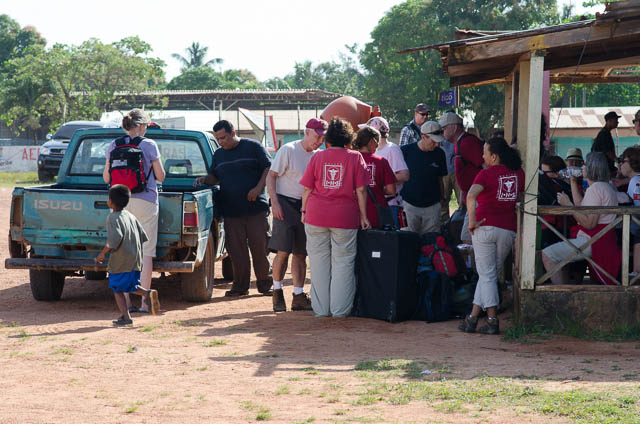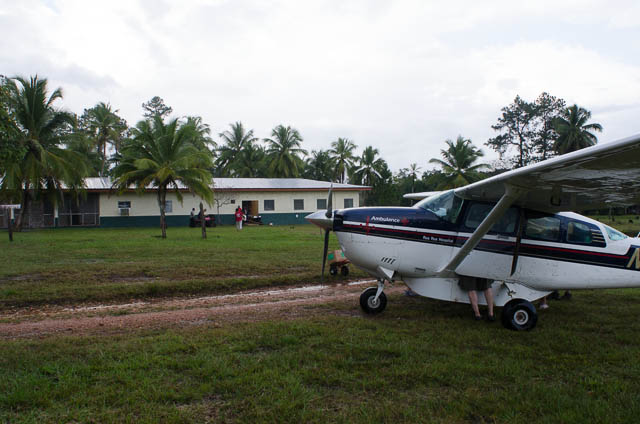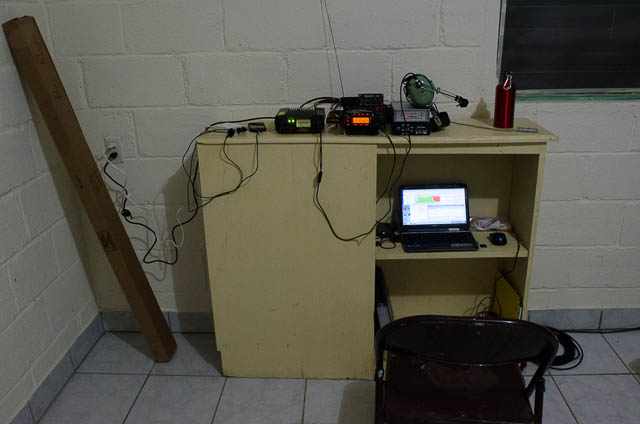In February of 2014 and 2015, my wife and I traveled to Honduras with IHS of MN on their annual brigada medica (medical brigade). This is a short summary of my experiences as a radio operator for the International Health Service of Minnesota (www.ihsmn.org).

The welcome
In 2014, during pre-deployment briefing at our hotel in La Ceiba, Honduras, our team leader reminded us that there was no cellphone, no Internet, and they’d even been having problems with their satellite radio at our destination. The only reliable communication in the area would be HF amateur radio. Conditions had improved by our return in 2015, but we were still miles from a cell tower and so for two weeks, my ham radio would be the only reliable communication for our medical team and the hundreds of patients we would see.
No pressure.
The mission
For over 30 years, the International Health Service of Minnesota, or IHS, has organized one or two brigadas medicas (medical brigades) each year to Honduras. IHS brings together just over 100 volunteer doctors, nurses, pharmacists, and support staff to deliver desperately needed health and dental care to remote areas of Honduras.

These visits provide the only health care for many of the patients that the teams see. In both 2014 and 2015, medical, dental, and surgical teams went to 10 different locations in Honduras. Each team included the medical staff: the doctors, dentists, nurses, pharmacists, and the support staff: an interpreter, a radio operator, a team leader, and a general helper or two. Our trip in 2014 was the first time my wife and I participated with IHS —my wife as an interpreter and I as a radio operator.
The location
My wife and I were on the team deployed to the hospital in Rus Rus, Honduras. The hospital is really more of a clinic, which was built in the 1980s to handle Nicaraguan refugees during the civil war. The hospital suffered from some neglect over the years, but a missionary group is in the process of renovating it. While very clean and in good shape, it is still, however, very rustic. Some teams on these trips worked under more civilized conditions while other teams arrived to work in even more humble locations—using only the supplies and facilities that they brought.

Normally, the village of Rus Rus has a population of about 150. During our visit, however, it tripled in size. While Rus Rus is only 60 miles from the nearest city, the port city of Puerto Lempira, the intervening swamp and jungle make those 60 miles a 12-hour ordeal over land—if you can find someone willing to make the trip. The road is more of a mule trail and the Cessna 206 air ambulance that the missionaries operate provides the only reasonable means of transportation in the area.

The radio
In Rus Rus, there is no commercial electricity, no cell phone, and no Internet. In the city of Puerto Lempira, the government had shut off the Internet and cell phone service and, even on a good day, commercial power and telephone service is unreliable. For us, in Rus Rus, a 10-kilowatt diesel generator provided power to the hospital from sun-up to shortly after sundown. We had to run it sparingly because all the fuel had to be delivered by the air ambulance in 5-gallon plastic gas cans. A 12-volt battery from one of the missionary’s tractors powered the radio equipment when the generator was not running.

All of the radio communications went through my Yaesu FT-857D, which was connected to a mini G5RV. The teams conducted a 40-meter voice net, three-times a day, and ran Winlink 2000 to exchange e-mail as often as the message traffic required and N5TW’s station in Texas made sure we always had a reliable Winlink gateway. Typical message traffic included patient consults from the team’s doctor, coordinating patient transfers for the air ambulance, and routine, logistical traffic to coordinate supplies. A couple of emergency cases required coordination between the surgeon, who lived about 100 miles to the north and the hospital, located in Puerto Lempira, 60 miles to the east. Using the ham radio to pass e-mail and voice traffic, and the Cessna 206 for the transportation, we were able to bring everyone together.
As is often the case, radio duties were feast-or-famine. Sometimes, I would have everyone standing behind me to hear a message or I would have to run to the clinic to deliver a message to the team’s doctor. Other times, there would be nothing to do on the radio so I would help the medical and pharmacy staff as an interpreter in the hospital or just talk to the people outside the hospital. With all the patients we saw, there was always something to do.
The reward
The opportunity to support the medical team so they could care for the hundreds of patients we saw would have been plenty of reward. However, seeing all the people we helped—the families, the children, and their spirit of community—provided a reward that is hard to put into words. My wife & I had the chance to talk with many of people who came to visit us and learn about their villages, families, and the journey to visit the clinic. Some patients had walked with their children for more than a day through the jungle just to visit the clinic.

The adventure
Traveling to and living in a tropical jungle is almost the very definition of adventure. In our trip to La Mosquitia in eastern Honduras, the airplanes and airports got smaller at each stop along the way. If you do not bring it with you, you do not have it and you cannot buy it—this included the radio gear.

The trip went very smoothly—a testament to the decades of experience that IHS has acquired. IHS is always seeking enthusiastic volunteers. Visit their web site (www.ihsmn.org) for more information.
Related posts
Links
- ihsmn.org – International Health Service of Minnesota (the organizing organization)
- IHS of MN on Facebook
- missionaryairgroup.org – Missionary Air Group (provides the air ambulance in Rus Rus)
- Winlink 2000 in the Jungle (Nov. 2004 issue of QST)
- http://www.eham.net/articles/5813 – Article by another ham about an earlier trip, Hams Need Help with Medical Mission Group Going to Honduras on eHam.net
